Managing Innovation: HelloFresh Case Study and Theory Analysis
VerifiedAdded on 2022/12/15
|11
|3429
|143
Report
AI Summary
This report examines the concept of innovation, focusing on the meal kit provider HelloFresh. It begins by defining innovation and then delves into Schumpeter's and disruptive innovation theories, with a detailed explanation of the latter. The main body applies the disruptive innovation theory to explain HelloFresh's historical development, detailing how the company entered the market and achieved success. The report highlights the steps of disruptive innovation, including how HelloFresh catered to the low-end market and gradually attracted a broader consumer base. Furthermore, it discusses why established companies often struggle to compete with disruptive innovators, referencing the five principles of disruption. Finally, the report concludes with recommendations for HelloFresh's future progress based on the innovation theories discussed.
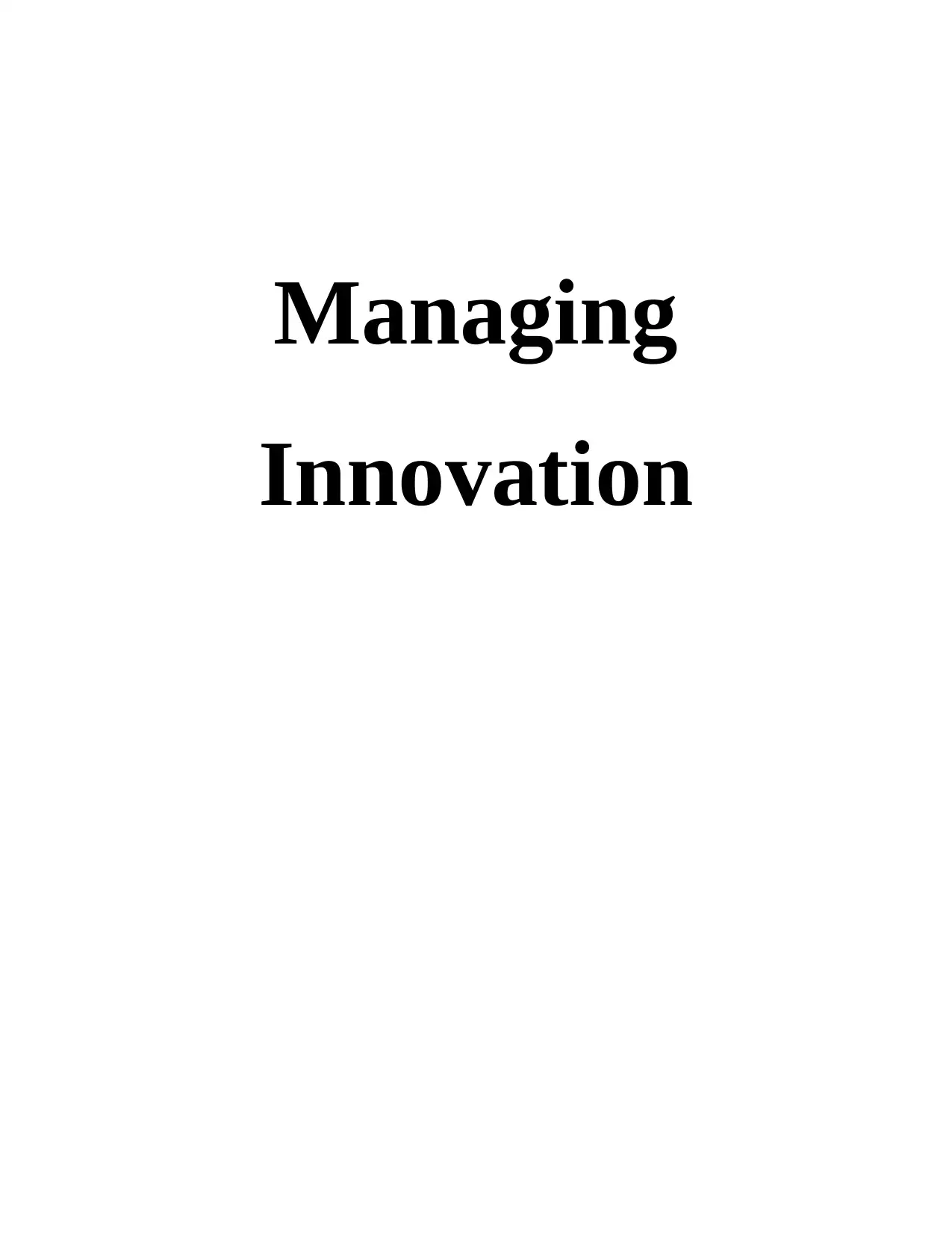
Managing
Innovation
Innovation
Paraphrase This Document
Need a fresh take? Get an instant paraphrase of this document with our AI Paraphraser
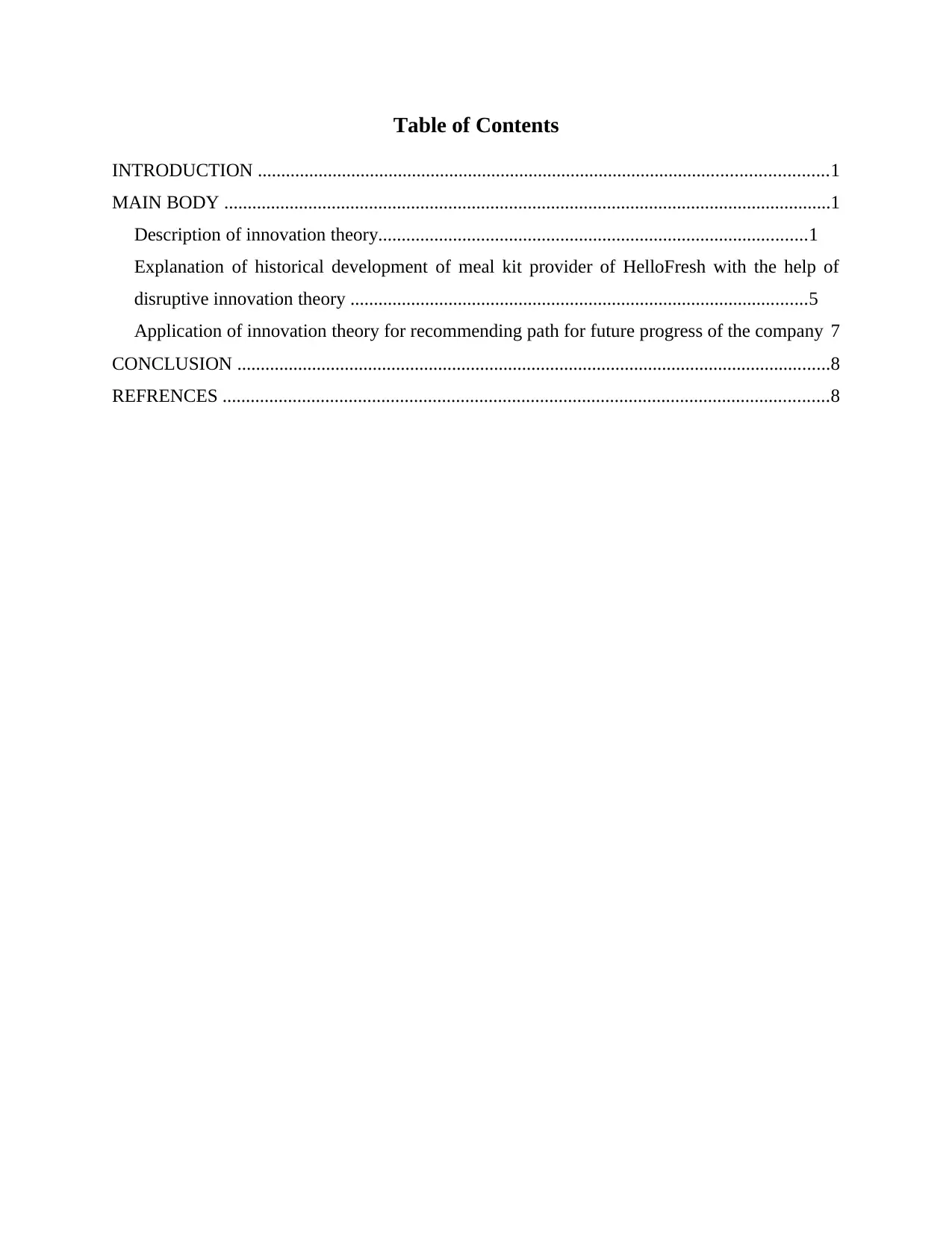
Table of Contents
INTRODUCTION ..........................................................................................................................1
MAIN BODY ..................................................................................................................................1
Description of innovation theory............................................................................................1
Explanation of historical development of meal kit provider of HelloFresh with the help of
disruptive innovation theory ..................................................................................................5
Application of innovation theory for recommending path for future progress of the company 7
CONCLUSION ...............................................................................................................................8
REFRENCES ..................................................................................................................................8
INTRODUCTION ..........................................................................................................................1
MAIN BODY ..................................................................................................................................1
Description of innovation theory............................................................................................1
Explanation of historical development of meal kit provider of HelloFresh with the help of
disruptive innovation theory ..................................................................................................5
Application of innovation theory for recommending path for future progress of the company 7
CONCLUSION ...............................................................................................................................8
REFRENCES ..................................................................................................................................8
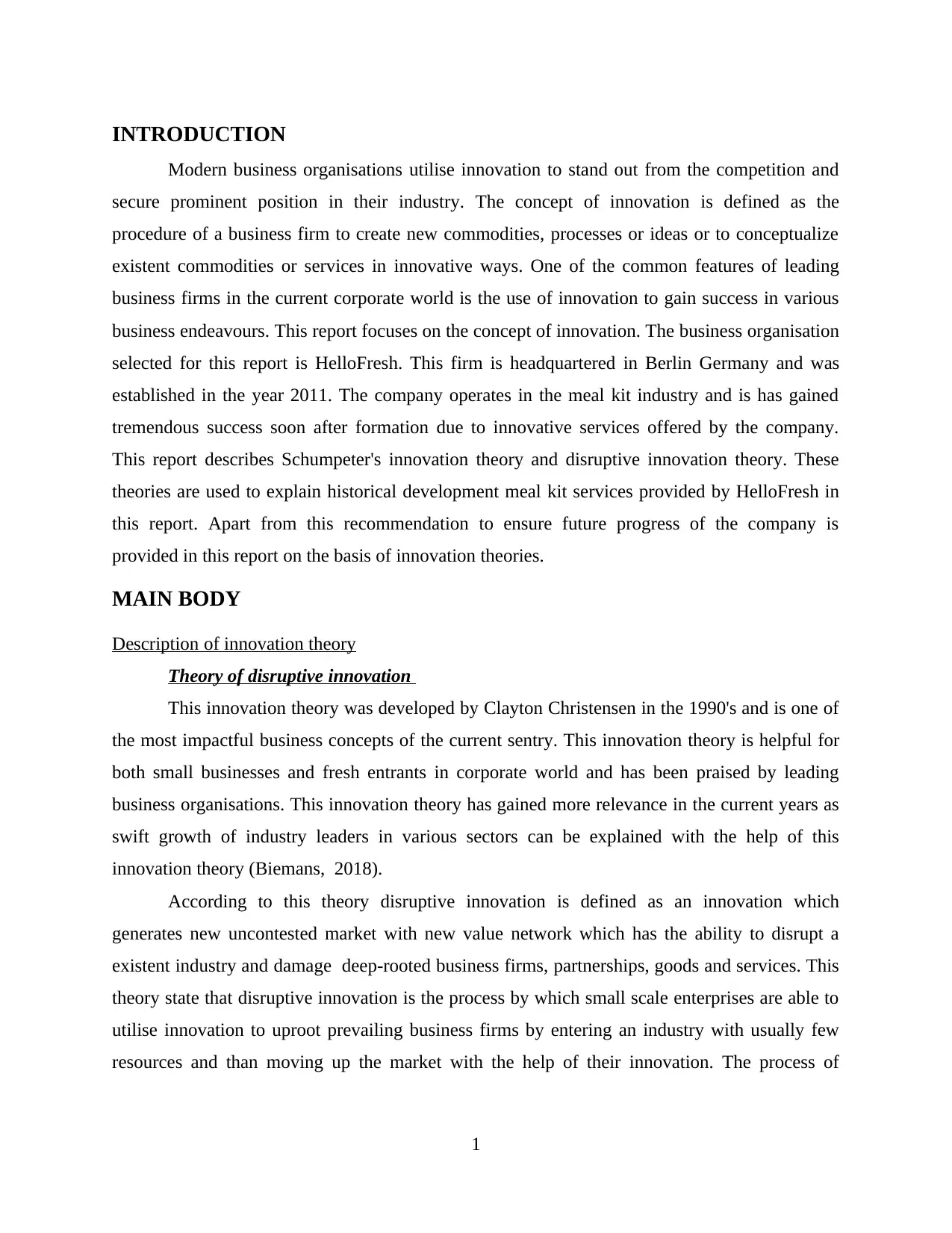
INTRODUCTION
Modern business organisations utilise innovation to stand out from the competition and
secure prominent position in their industry. The concept of innovation is defined as the
procedure of a business firm to create new commodities, processes or ideas or to conceptualize
existent commodities or services in innovative ways. One of the common features of leading
business firms in the current corporate world is the use of innovation to gain success in various
business endeavours. This report focuses on the concept of innovation. The business organisation
selected for this report is HelloFresh. This firm is headquartered in Berlin Germany and was
established in the year 2011. The company operates in the meal kit industry and is has gained
tremendous success soon after formation due to innovative services offered by the company.
This report describes Schumpeter's innovation theory and disruptive innovation theory. These
theories are used to explain historical development meal kit services provided by HelloFresh in
this report. Apart from this recommendation to ensure future progress of the company is
provided in this report on the basis of innovation theories.
MAIN BODY
Description of innovation theory
Theory of disruptive innovation
This innovation theory was developed by Clayton Christensen in the 1990's and is one of
the most impactful business concepts of the current sentry. This innovation theory is helpful for
both small businesses and fresh entrants in corporate world and has been praised by leading
business organisations. This innovation theory has gained more relevance in the current years as
swift growth of industry leaders in various sectors can be explained with the help of this
innovation theory (Biemans, 2018).
According to this theory disruptive innovation is defined as an innovation which
generates new uncontested market with new value network which has the ability to disrupt a
existent industry and damage deep-rooted business firms, partnerships, goods and services. This
theory state that disruptive innovation is the process by which small scale enterprises are able to
utilise innovation to uproot prevailing business firms by entering an industry with usually few
resources and than moving up the market with the help of their innovation. The process of
1
Modern business organisations utilise innovation to stand out from the competition and
secure prominent position in their industry. The concept of innovation is defined as the
procedure of a business firm to create new commodities, processes or ideas or to conceptualize
existent commodities or services in innovative ways. One of the common features of leading
business firms in the current corporate world is the use of innovation to gain success in various
business endeavours. This report focuses on the concept of innovation. The business organisation
selected for this report is HelloFresh. This firm is headquartered in Berlin Germany and was
established in the year 2011. The company operates in the meal kit industry and is has gained
tremendous success soon after formation due to innovative services offered by the company.
This report describes Schumpeter's innovation theory and disruptive innovation theory. These
theories are used to explain historical development meal kit services provided by HelloFresh in
this report. Apart from this recommendation to ensure future progress of the company is
provided in this report on the basis of innovation theories.
MAIN BODY
Description of innovation theory
Theory of disruptive innovation
This innovation theory was developed by Clayton Christensen in the 1990's and is one of
the most impactful business concepts of the current sentry. This innovation theory is helpful for
both small businesses and fresh entrants in corporate world and has been praised by leading
business organisations. This innovation theory has gained more relevance in the current years as
swift growth of industry leaders in various sectors can be explained with the help of this
innovation theory (Biemans, 2018).
According to this theory disruptive innovation is defined as an innovation which
generates new uncontested market with new value network which has the ability to disrupt a
existent industry and damage deep-rooted business firms, partnerships, goods and services. This
theory state that disruptive innovation is the process by which small scale enterprises are able to
utilise innovation to uproot prevailing business firms by entering an industry with usually few
resources and than moving up the market with the help of their innovation. The process of
1
⊘ This is a preview!⊘
Do you want full access?
Subscribe today to unlock all pages.

Trusted by 1+ million students worldwide
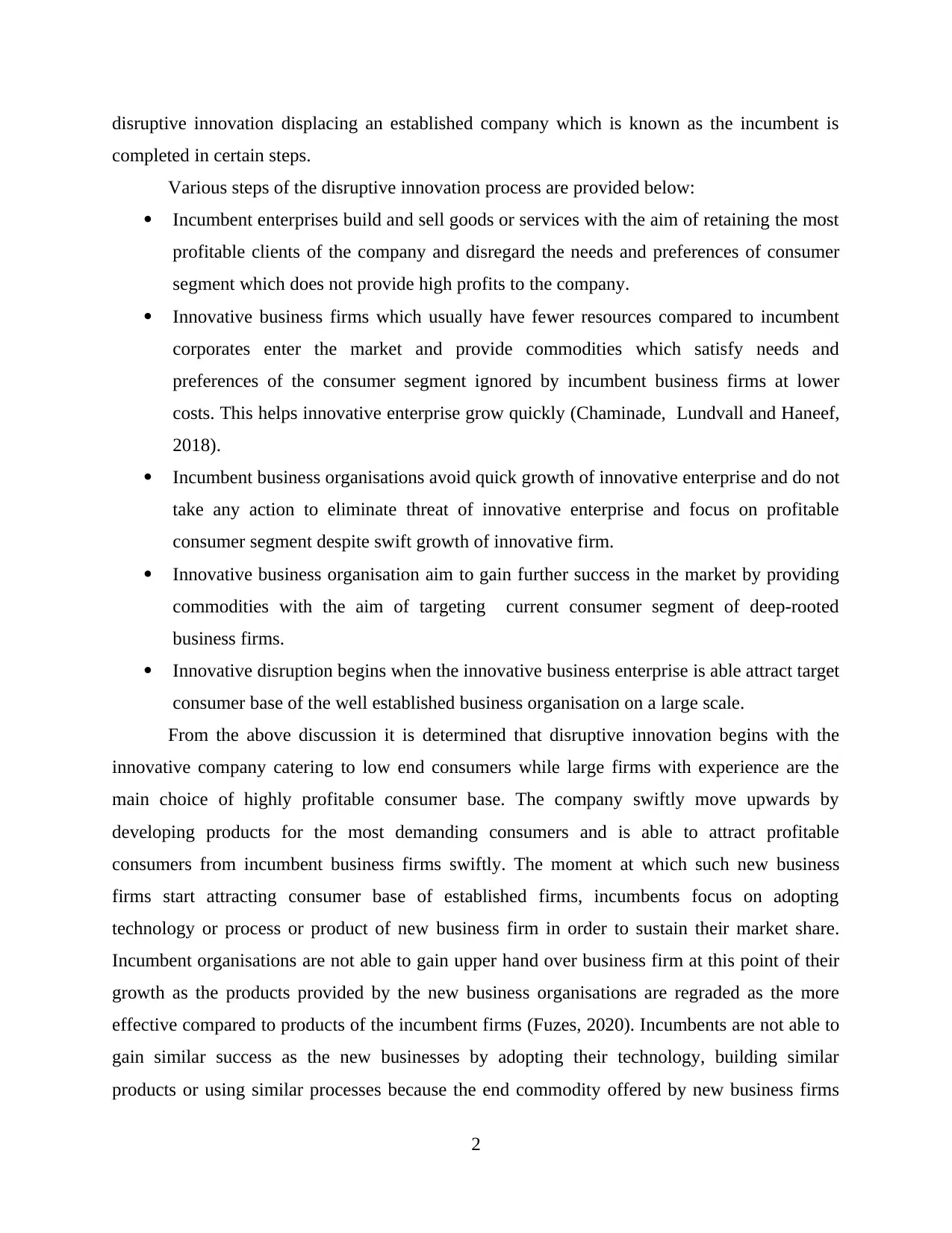
disruptive innovation displacing an established company which is known as the incumbent is
completed in certain steps.
Various steps of the disruptive innovation process are provided below:
Incumbent enterprises build and sell goods or services with the aim of retaining the most
profitable clients of the company and disregard the needs and preferences of consumer
segment which does not provide high profits to the company.
Innovative business firms which usually have fewer resources compared to incumbent
corporates enter the market and provide commodities which satisfy needs and
preferences of the consumer segment ignored by incumbent business firms at lower
costs. This helps innovative enterprise grow quickly (Chaminade, Lundvall and Haneef,
2018).
Incumbent business organisations avoid quick growth of innovative enterprise and do not
take any action to eliminate threat of innovative enterprise and focus on profitable
consumer segment despite swift growth of innovative firm.
Innovative business organisation aim to gain further success in the market by providing
commodities with the aim of targeting current consumer segment of deep-rooted
business firms.
Innovative disruption begins when the innovative business enterprise is able attract target
consumer base of the well established business organisation on a large scale.
From the above discussion it is determined that disruptive innovation begins with the
innovative company catering to low end consumers while large firms with experience are the
main choice of highly profitable consumer base. The company swiftly move upwards by
developing products for the most demanding consumers and is able to attract profitable
consumers from incumbent business firms swiftly. The moment at which such new business
firms start attracting consumer base of established firms, incumbents focus on adopting
technology or process or product of new business firm in order to sustain their market share.
Incumbent organisations are not able to gain upper hand over business firm at this point of their
growth as the products provided by the new business organisations are regraded as the more
effective compared to products of the incumbent firms (Fuzes, 2020). Incumbents are not able to
gain similar success as the new businesses by adopting their technology, building similar
products or using similar processes because the end commodity offered by new business firms
2
completed in certain steps.
Various steps of the disruptive innovation process are provided below:
Incumbent enterprises build and sell goods or services with the aim of retaining the most
profitable clients of the company and disregard the needs and preferences of consumer
segment which does not provide high profits to the company.
Innovative business firms which usually have fewer resources compared to incumbent
corporates enter the market and provide commodities which satisfy needs and
preferences of the consumer segment ignored by incumbent business firms at lower
costs. This helps innovative enterprise grow quickly (Chaminade, Lundvall and Haneef,
2018).
Incumbent business organisations avoid quick growth of innovative enterprise and do not
take any action to eliminate threat of innovative enterprise and focus on profitable
consumer segment despite swift growth of innovative firm.
Innovative business organisation aim to gain further success in the market by providing
commodities with the aim of targeting current consumer segment of deep-rooted
business firms.
Innovative disruption begins when the innovative business enterprise is able attract target
consumer base of the well established business organisation on a large scale.
From the above discussion it is determined that disruptive innovation begins with the
innovative company catering to low end consumers while large firms with experience are the
main choice of highly profitable consumer base. The company swiftly move upwards by
developing products for the most demanding consumers and is able to attract profitable
consumers from incumbent business firms swiftly. The moment at which such new business
firms start attracting consumer base of established firms, incumbents focus on adopting
technology or process or product of new business firm in order to sustain their market share.
Incumbent organisations are not able to gain upper hand over business firm at this point of their
growth as the products provided by the new business organisations are regraded as the more
effective compared to products of the incumbent firms (Fuzes, 2020). Incumbents are not able to
gain similar success as the new businesses by adopting their technology, building similar
products or using similar processes because the end commodity offered by new business firms
2
Paraphrase This Document
Need a fresh take? Get an instant paraphrase of this document with our AI Paraphraser
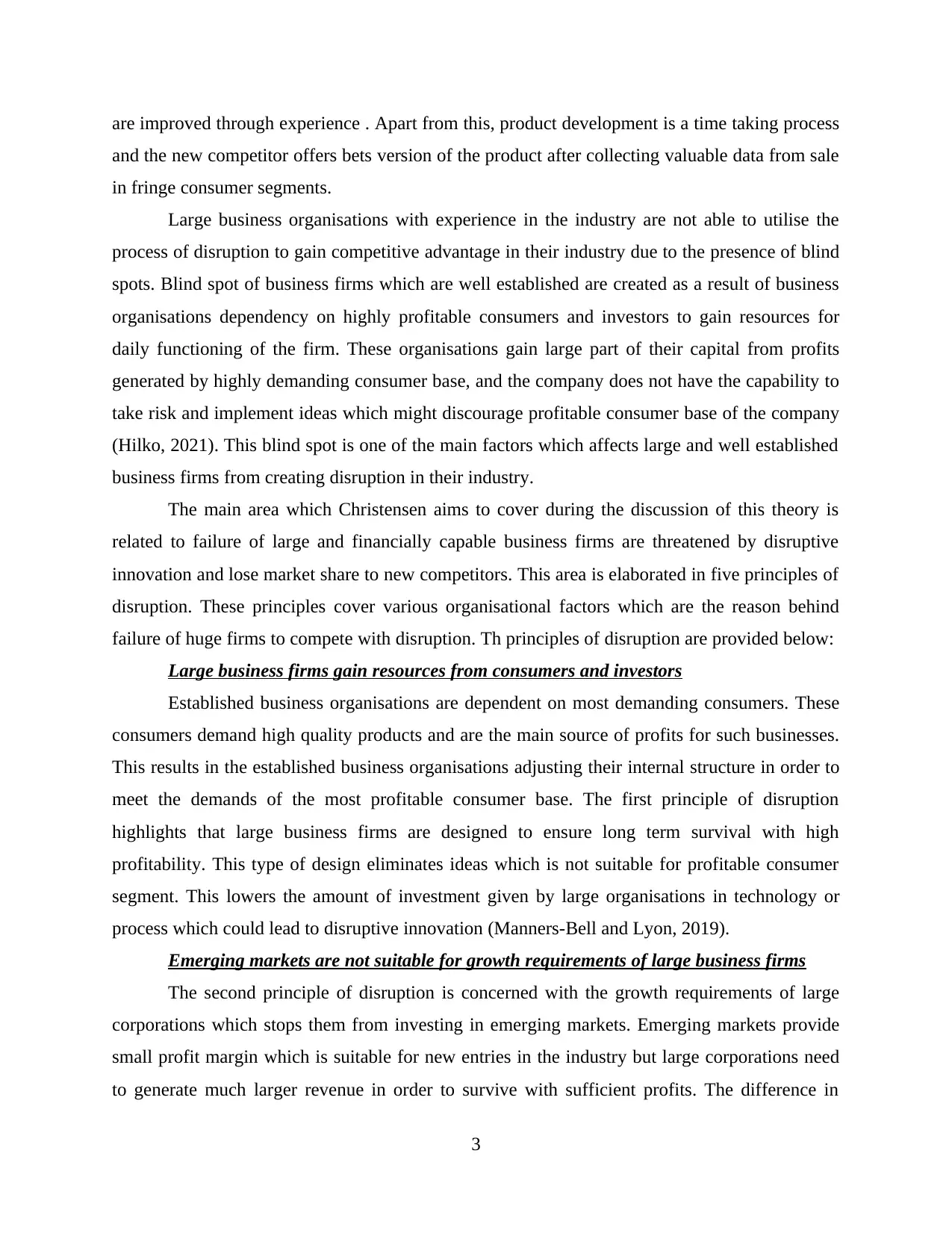
are improved through experience . Apart from this, product development is a time taking process
and the new competitor offers bets version of the product after collecting valuable data from sale
in fringe consumer segments.
Large business organisations with experience in the industry are not able to utilise the
process of disruption to gain competitive advantage in their industry due to the presence of blind
spots. Blind spot of business firms which are well established are created as a result of business
organisations dependency on highly profitable consumers and investors to gain resources for
daily functioning of the firm. These organisations gain large part of their capital from profits
generated by highly demanding consumer base, and the company does not have the capability to
take risk and implement ideas which might discourage profitable consumer base of the company
(Hilko, 2021). This blind spot is one of the main factors which affects large and well established
business firms from creating disruption in their industry.
The main area which Christensen aims to cover during the discussion of this theory is
related to failure of large and financially capable business firms are threatened by disruptive
innovation and lose market share to new competitors. This area is elaborated in five principles of
disruption. These principles cover various organisational factors which are the reason behind
failure of huge firms to compete with disruption. Th principles of disruption are provided below:
Large business firms gain resources from consumers and investors
Established business organisations are dependent on most demanding consumers. These
consumers demand high quality products and are the main source of profits for such businesses.
This results in the established business organisations adjusting their internal structure in order to
meet the demands of the most profitable consumer base. The first principle of disruption
highlights that large business firms are designed to ensure long term survival with high
profitability. This type of design eliminates ideas which is not suitable for profitable consumer
segment. This lowers the amount of investment given by large organisations in technology or
process which could lead to disruptive innovation (Manners-Bell and Lyon, 2019).
Emerging markets are not suitable for growth requirements of large business firms
The second principle of disruption is concerned with the growth requirements of large
corporations which stops them from investing in emerging markets. Emerging markets provide
small profit margin which is suitable for new entries in the industry but large corporations need
to generate much larger revenue in order to survive with sufficient profits. The difference in
3
and the new competitor offers bets version of the product after collecting valuable data from sale
in fringe consumer segments.
Large business organisations with experience in the industry are not able to utilise the
process of disruption to gain competitive advantage in their industry due to the presence of blind
spots. Blind spot of business firms which are well established are created as a result of business
organisations dependency on highly profitable consumers and investors to gain resources for
daily functioning of the firm. These organisations gain large part of their capital from profits
generated by highly demanding consumer base, and the company does not have the capability to
take risk and implement ideas which might discourage profitable consumer base of the company
(Hilko, 2021). This blind spot is one of the main factors which affects large and well established
business firms from creating disruption in their industry.
The main area which Christensen aims to cover during the discussion of this theory is
related to failure of large and financially capable business firms are threatened by disruptive
innovation and lose market share to new competitors. This area is elaborated in five principles of
disruption. These principles cover various organisational factors which are the reason behind
failure of huge firms to compete with disruption. Th principles of disruption are provided below:
Large business firms gain resources from consumers and investors
Established business organisations are dependent on most demanding consumers. These
consumers demand high quality products and are the main source of profits for such businesses.
This results in the established business organisations adjusting their internal structure in order to
meet the demands of the most profitable consumer base. The first principle of disruption
highlights that large business firms are designed to ensure long term survival with high
profitability. This type of design eliminates ideas which is not suitable for profitable consumer
segment. This lowers the amount of investment given by large organisations in technology or
process which could lead to disruptive innovation (Manners-Bell and Lyon, 2019).
Emerging markets are not suitable for growth requirements of large business firms
The second principle of disruption is concerned with the growth requirements of large
corporations which stops them from investing in emerging markets. Emerging markets provide
small profit margin which is suitable for new entries in the industry but large corporations need
to generate much larger revenue in order to survive with sufficient profits. The difference in
3
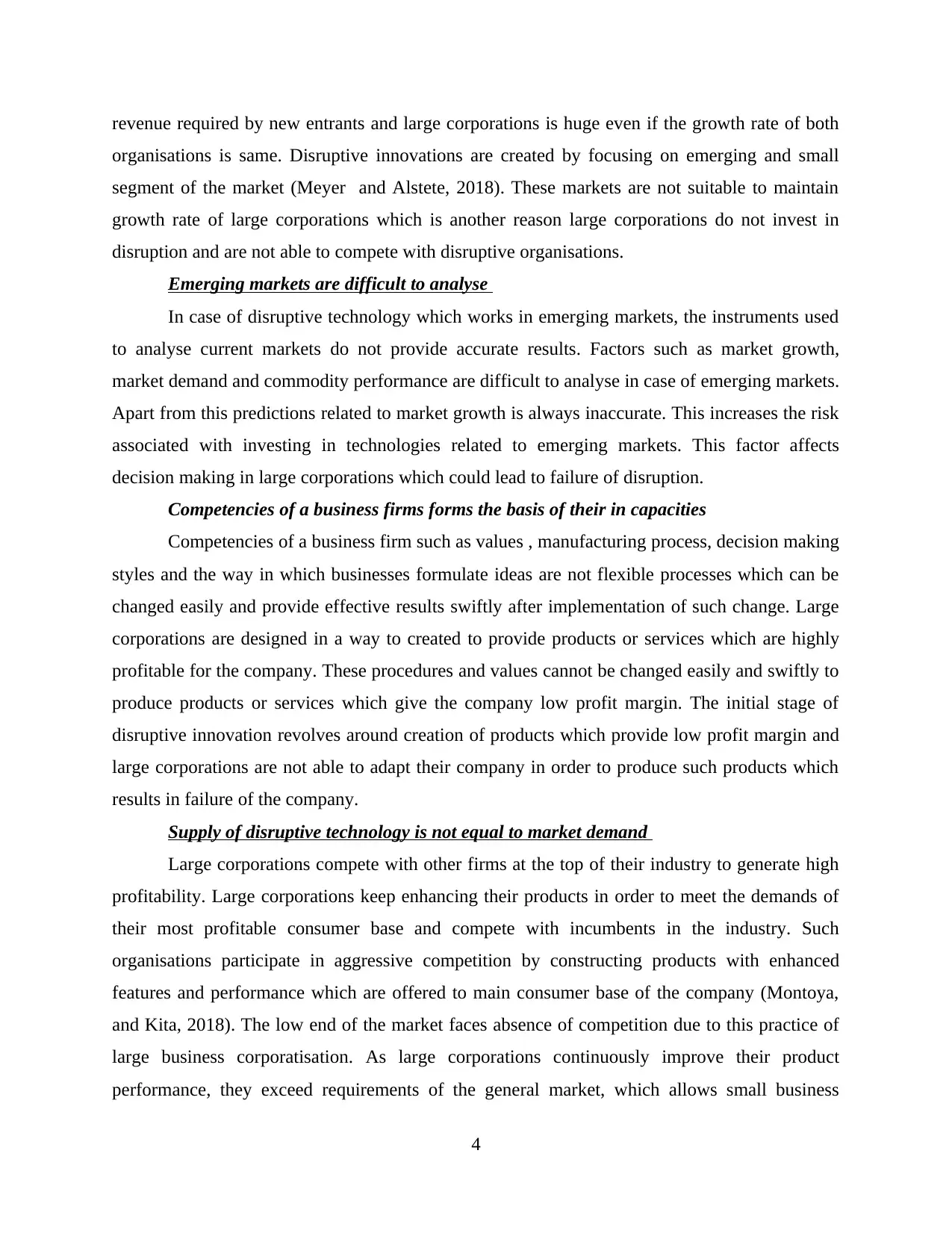
revenue required by new entrants and large corporations is huge even if the growth rate of both
organisations is same. Disruptive innovations are created by focusing on emerging and small
segment of the market (Meyer and Alstete, 2018). These markets are not suitable to maintain
growth rate of large corporations which is another reason large corporations do not invest in
disruption and are not able to compete with disruptive organisations.
Emerging markets are difficult to analyse
In case of disruptive technology which works in emerging markets, the instruments used
to analyse current markets do not provide accurate results. Factors such as market growth,
market demand and commodity performance are difficult to analyse in case of emerging markets.
Apart from this predictions related to market growth is always inaccurate. This increases the risk
associated with investing in technologies related to emerging markets. This factor affects
decision making in large corporations which could lead to failure of disruption.
Competencies of a business firms forms the basis of their in capacities
Competencies of a business firm such as values , manufacturing process, decision making
styles and the way in which businesses formulate ideas are not flexible processes which can be
changed easily and provide effective results swiftly after implementation of such change. Large
corporations are designed in a way to created to provide products or services which are highly
profitable for the company. These procedures and values cannot be changed easily and swiftly to
produce products or services which give the company low profit margin. The initial stage of
disruptive innovation revolves around creation of products which provide low profit margin and
large corporations are not able to adapt their company in order to produce such products which
results in failure of the company.
Supply of disruptive technology is not equal to market demand
Large corporations compete with other firms at the top of their industry to generate high
profitability. Large corporations keep enhancing their products in order to meet the demands of
their most profitable consumer base and compete with incumbents in the industry. Such
organisations participate in aggressive competition by constructing products with enhanced
features and performance which are offered to main consumer base of the company (Montoya,
and Kita, 2018). The low end of the market faces absence of competition due to this practice of
large business corporatisation. As large corporations continuously improve their product
performance, they exceed requirements of the general market, which allows small business
4
organisations is same. Disruptive innovations are created by focusing on emerging and small
segment of the market (Meyer and Alstete, 2018). These markets are not suitable to maintain
growth rate of large corporations which is another reason large corporations do not invest in
disruption and are not able to compete with disruptive organisations.
Emerging markets are difficult to analyse
In case of disruptive technology which works in emerging markets, the instruments used
to analyse current markets do not provide accurate results. Factors such as market growth,
market demand and commodity performance are difficult to analyse in case of emerging markets.
Apart from this predictions related to market growth is always inaccurate. This increases the risk
associated with investing in technologies related to emerging markets. This factor affects
decision making in large corporations which could lead to failure of disruption.
Competencies of a business firms forms the basis of their in capacities
Competencies of a business firm such as values , manufacturing process, decision making
styles and the way in which businesses formulate ideas are not flexible processes which can be
changed easily and provide effective results swiftly after implementation of such change. Large
corporations are designed in a way to created to provide products or services which are highly
profitable for the company. These procedures and values cannot be changed easily and swiftly to
produce products or services which give the company low profit margin. The initial stage of
disruptive innovation revolves around creation of products which provide low profit margin and
large corporations are not able to adapt their company in order to produce such products which
results in failure of the company.
Supply of disruptive technology is not equal to market demand
Large corporations compete with other firms at the top of their industry to generate high
profitability. Large corporations keep enhancing their products in order to meet the demands of
their most profitable consumer base and compete with incumbents in the industry. Such
organisations participate in aggressive competition by constructing products with enhanced
features and performance which are offered to main consumer base of the company (Montoya,
and Kita, 2018). The low end of the market faces absence of competition due to this practice of
large business corporatisation. As large corporations continuously improve their product
performance, they exceed requirements of the general market, which allows small business
4
⊘ This is a preview!⊘
Do you want full access?
Subscribe today to unlock all pages.

Trusted by 1+ million students worldwide
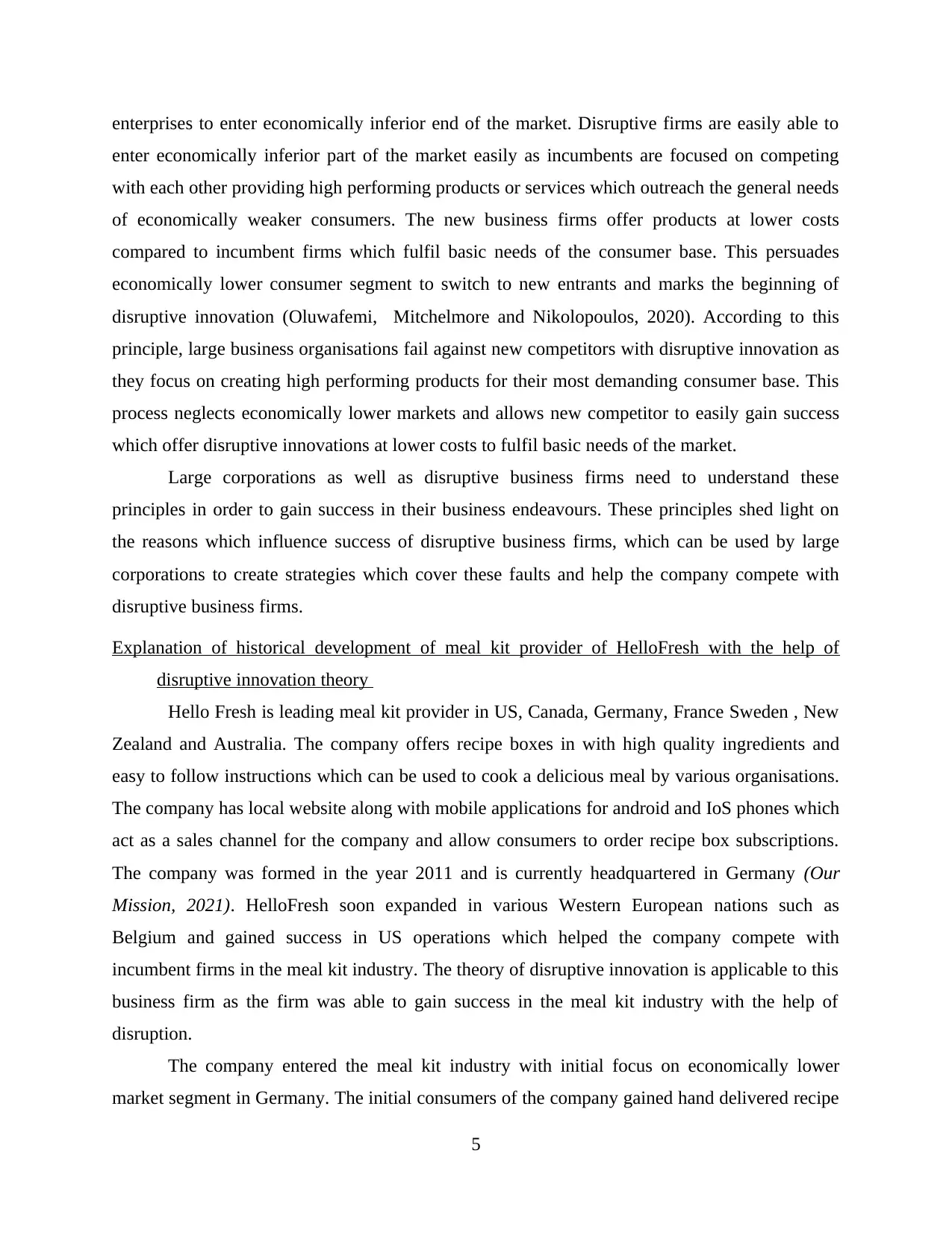
enterprises to enter economically inferior end of the market. Disruptive firms are easily able to
enter economically inferior part of the market easily as incumbents are focused on competing
with each other providing high performing products or services which outreach the general needs
of economically weaker consumers. The new business firms offer products at lower costs
compared to incumbent firms which fulfil basic needs of the consumer base. This persuades
economically lower consumer segment to switch to new entrants and marks the beginning of
disruptive innovation (Oluwafemi, Mitchelmore and Nikolopoulos, 2020). According to this
principle, large business organisations fail against new competitors with disruptive innovation as
they focus on creating high performing products for their most demanding consumer base. This
process neglects economically lower markets and allows new competitor to easily gain success
which offer disruptive innovations at lower costs to fulfil basic needs of the market.
Large corporations as well as disruptive business firms need to understand these
principles in order to gain success in their business endeavours. These principles shed light on
the reasons which influence success of disruptive business firms, which can be used by large
corporations to create strategies which cover these faults and help the company compete with
disruptive business firms.
Explanation of historical development of meal kit provider of HelloFresh with the help of
disruptive innovation theory
Hello Fresh is leading meal kit provider in US, Canada, Germany, France Sweden , New
Zealand and Australia. The company offers recipe boxes in with high quality ingredients and
easy to follow instructions which can be used to cook a delicious meal by various organisations.
The company has local website along with mobile applications for android and IoS phones which
act as a sales channel for the company and allow consumers to order recipe box subscriptions.
The company was formed in the year 2011 and is currently headquartered in Germany (Our
Mission, 2021). HelloFresh soon expanded in various Western European nations such as
Belgium and gained success in US operations which helped the company compete with
incumbent firms in the meal kit industry. The theory of disruptive innovation is applicable to this
business firm as the firm was able to gain success in the meal kit industry with the help of
disruption.
The company entered the meal kit industry with initial focus on economically lower
market segment in Germany. The initial consumers of the company gained hand delivered recipe
5
enter economically inferior part of the market easily as incumbents are focused on competing
with each other providing high performing products or services which outreach the general needs
of economically weaker consumers. The new business firms offer products at lower costs
compared to incumbent firms which fulfil basic needs of the consumer base. This persuades
economically lower consumer segment to switch to new entrants and marks the beginning of
disruptive innovation (Oluwafemi, Mitchelmore and Nikolopoulos, 2020). According to this
principle, large business organisations fail against new competitors with disruptive innovation as
they focus on creating high performing products for their most demanding consumer base. This
process neglects economically lower markets and allows new competitor to easily gain success
which offer disruptive innovations at lower costs to fulfil basic needs of the market.
Large corporations as well as disruptive business firms need to understand these
principles in order to gain success in their business endeavours. These principles shed light on
the reasons which influence success of disruptive business firms, which can be used by large
corporations to create strategies which cover these faults and help the company compete with
disruptive business firms.
Explanation of historical development of meal kit provider of HelloFresh with the help of
disruptive innovation theory
Hello Fresh is leading meal kit provider in US, Canada, Germany, France Sweden , New
Zealand and Australia. The company offers recipe boxes in with high quality ingredients and
easy to follow instructions which can be used to cook a delicious meal by various organisations.
The company has local website along with mobile applications for android and IoS phones which
act as a sales channel for the company and allow consumers to order recipe box subscriptions.
The company was formed in the year 2011 and is currently headquartered in Germany (Our
Mission, 2021). HelloFresh soon expanded in various Western European nations such as
Belgium and gained success in US operations which helped the company compete with
incumbent firms in the meal kit industry. The theory of disruptive innovation is applicable to this
business firm as the firm was able to gain success in the meal kit industry with the help of
disruption.
The company entered the meal kit industry with initial focus on economically lower
market segment in Germany. The initial consumers of the company gained hand delivered recipe
5
Paraphrase This Document
Need a fresh take? Get an instant paraphrase of this document with our AI Paraphraser
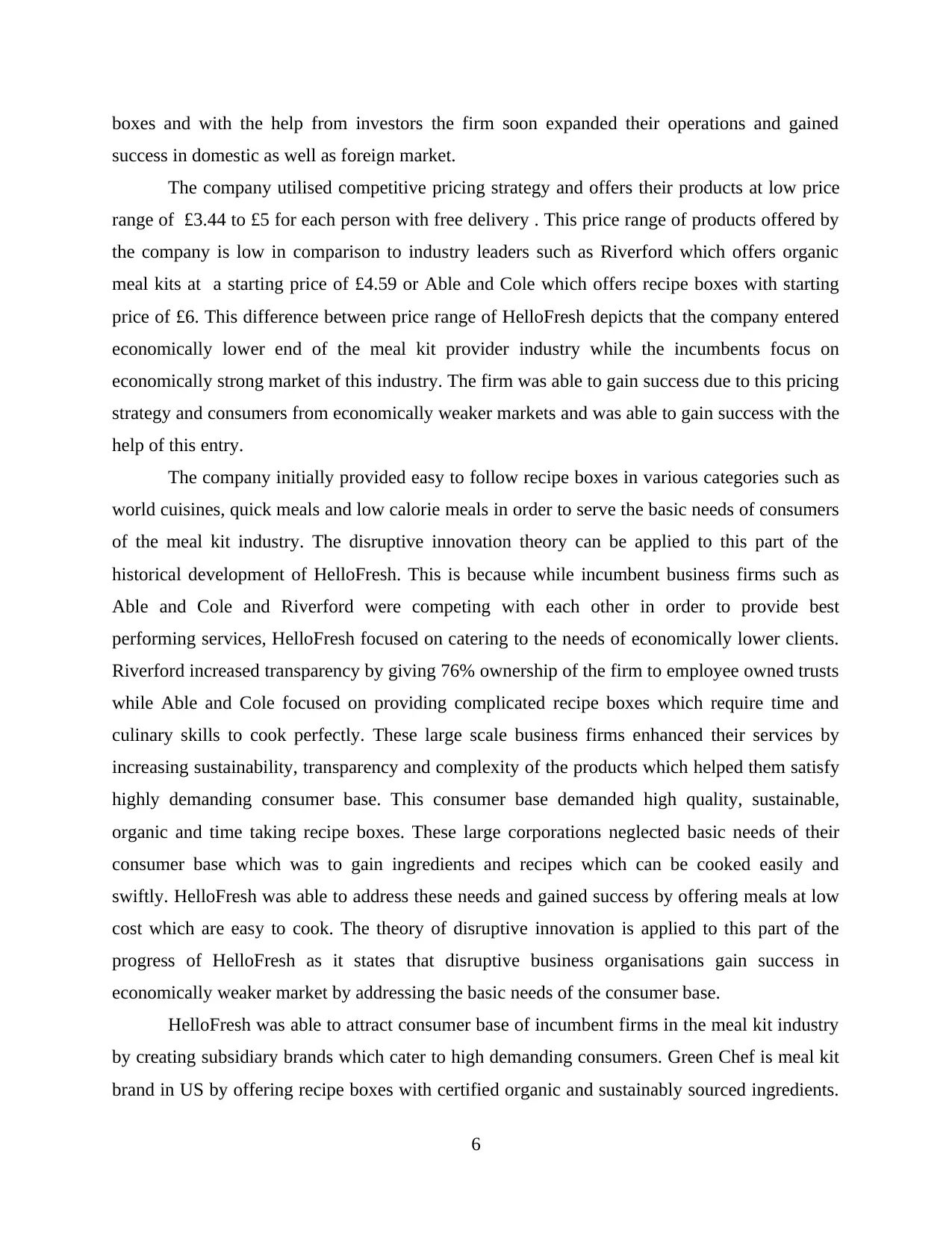
boxes and with the help from investors the firm soon expanded their operations and gained
success in domestic as well as foreign market.
The company utilised competitive pricing strategy and offers their products at low price
range of £3.44 to £5 for each person with free delivery . This price range of products offered by
the company is low in comparison to industry leaders such as Riverford which offers organic
meal kits at a starting price of £4.59 or Able and Cole which offers recipe boxes with starting
price of £6. This difference between price range of HelloFresh depicts that the company entered
economically lower end of the meal kit provider industry while the incumbents focus on
economically strong market of this industry. The firm was able to gain success due to this pricing
strategy and consumers from economically weaker markets and was able to gain success with the
help of this entry.
The company initially provided easy to follow recipe boxes in various categories such as
world cuisines, quick meals and low calorie meals in order to serve the basic needs of consumers
of the meal kit industry. The disruptive innovation theory can be applied to this part of the
historical development of HelloFresh. This is because while incumbent business firms such as
Able and Cole and Riverford were competing with each other in order to provide best
performing services, HelloFresh focused on catering to the needs of economically lower clients.
Riverford increased transparency by giving 76% ownership of the firm to employee owned trusts
while Able and Cole focused on providing complicated recipe boxes which require time and
culinary skills to cook perfectly. These large scale business firms enhanced their services by
increasing sustainability, transparency and complexity of the products which helped them satisfy
highly demanding consumer base. This consumer base demanded high quality, sustainable,
organic and time taking recipe boxes. These large corporations neglected basic needs of their
consumer base which was to gain ingredients and recipes which can be cooked easily and
swiftly. HelloFresh was able to address these needs and gained success by offering meals at low
cost which are easy to cook. The theory of disruptive innovation is applied to this part of the
progress of HelloFresh as it states that disruptive business organisations gain success in
economically weaker market by addressing the basic needs of the consumer base.
HelloFresh was able to attract consumer base of incumbent firms in the meal kit industry
by creating subsidiary brands which cater to high demanding consumers. Green Chef is meal kit
brand in US by offering recipe boxes with certified organic and sustainably sourced ingredients.
6
success in domestic as well as foreign market.
The company utilised competitive pricing strategy and offers their products at low price
range of £3.44 to £5 for each person with free delivery . This price range of products offered by
the company is low in comparison to industry leaders such as Riverford which offers organic
meal kits at a starting price of £4.59 or Able and Cole which offers recipe boxes with starting
price of £6. This difference between price range of HelloFresh depicts that the company entered
economically lower end of the meal kit provider industry while the incumbents focus on
economically strong market of this industry. The firm was able to gain success due to this pricing
strategy and consumers from economically weaker markets and was able to gain success with the
help of this entry.
The company initially provided easy to follow recipe boxes in various categories such as
world cuisines, quick meals and low calorie meals in order to serve the basic needs of consumers
of the meal kit industry. The disruptive innovation theory can be applied to this part of the
historical development of HelloFresh. This is because while incumbent business firms such as
Able and Cole and Riverford were competing with each other in order to provide best
performing services, HelloFresh focused on catering to the needs of economically lower clients.
Riverford increased transparency by giving 76% ownership of the firm to employee owned trusts
while Able and Cole focused on providing complicated recipe boxes which require time and
culinary skills to cook perfectly. These large scale business firms enhanced their services by
increasing sustainability, transparency and complexity of the products which helped them satisfy
highly demanding consumer base. This consumer base demanded high quality, sustainable,
organic and time taking recipe boxes. These large corporations neglected basic needs of their
consumer base which was to gain ingredients and recipes which can be cooked easily and
swiftly. HelloFresh was able to address these needs and gained success by offering meals at low
cost which are easy to cook. The theory of disruptive innovation is applied to this part of the
progress of HelloFresh as it states that disruptive business organisations gain success in
economically weaker market by addressing the basic needs of the consumer base.
HelloFresh was able to attract consumer base of incumbent firms in the meal kit industry
by creating subsidiary brands which cater to high demanding consumers. Green Chef is meal kit
brand in US by offering recipe boxes with certified organic and sustainably sourced ingredients.
6
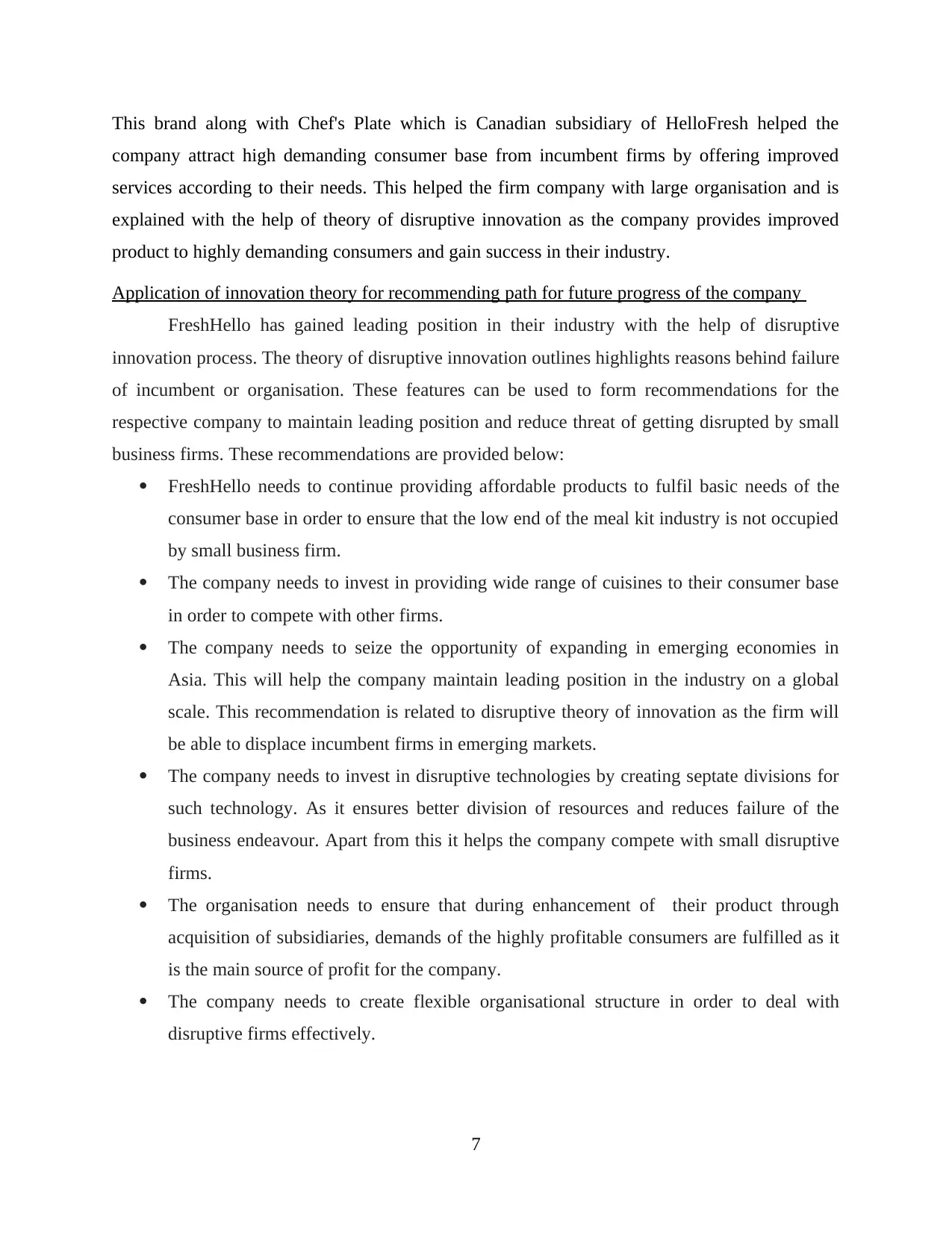
This brand along with Chef's Plate which is Canadian subsidiary of HelloFresh helped the
company attract high demanding consumer base from incumbent firms by offering improved
services according to their needs. This helped the firm company with large organisation and is
explained with the help of theory of disruptive innovation as the company provides improved
product to highly demanding consumers and gain success in their industry.
Application of innovation theory for recommending path for future progress of the company
FreshHello has gained leading position in their industry with the help of disruptive
innovation process. The theory of disruptive innovation outlines highlights reasons behind failure
of incumbent or organisation. These features can be used to form recommendations for the
respective company to maintain leading position and reduce threat of getting disrupted by small
business firms. These recommendations are provided below:
FreshHello needs to continue providing affordable products to fulfil basic needs of the
consumer base in order to ensure that the low end of the meal kit industry is not occupied
by small business firm.
The company needs to invest in providing wide range of cuisines to their consumer base
in order to compete with other firms.
The company needs to seize the opportunity of expanding in emerging economies in
Asia. This will help the company maintain leading position in the industry on a global
scale. This recommendation is related to disruptive theory of innovation as the firm will
be able to displace incumbent firms in emerging markets.
The company needs to invest in disruptive technologies by creating septate divisions for
such technology. As it ensures better division of resources and reduces failure of the
business endeavour. Apart from this it helps the company compete with small disruptive
firms.
The organisation needs to ensure that during enhancement of their product through
acquisition of subsidiaries, demands of the highly profitable consumers are fulfilled as it
is the main source of profit for the company.
The company needs to create flexible organisational structure in order to deal with
disruptive firms effectively.
7
company attract high demanding consumer base from incumbent firms by offering improved
services according to their needs. This helped the firm company with large organisation and is
explained with the help of theory of disruptive innovation as the company provides improved
product to highly demanding consumers and gain success in their industry.
Application of innovation theory for recommending path for future progress of the company
FreshHello has gained leading position in their industry with the help of disruptive
innovation process. The theory of disruptive innovation outlines highlights reasons behind failure
of incumbent or organisation. These features can be used to form recommendations for the
respective company to maintain leading position and reduce threat of getting disrupted by small
business firms. These recommendations are provided below:
FreshHello needs to continue providing affordable products to fulfil basic needs of the
consumer base in order to ensure that the low end of the meal kit industry is not occupied
by small business firm.
The company needs to invest in providing wide range of cuisines to their consumer base
in order to compete with other firms.
The company needs to seize the opportunity of expanding in emerging economies in
Asia. This will help the company maintain leading position in the industry on a global
scale. This recommendation is related to disruptive theory of innovation as the firm will
be able to displace incumbent firms in emerging markets.
The company needs to invest in disruptive technologies by creating septate divisions for
such technology. As it ensures better division of resources and reduces failure of the
business endeavour. Apart from this it helps the company compete with small disruptive
firms.
The organisation needs to ensure that during enhancement of their product through
acquisition of subsidiaries, demands of the highly profitable consumers are fulfilled as it
is the main source of profit for the company.
The company needs to create flexible organisational structure in order to deal with
disruptive firms effectively.
7
⊘ This is a preview!⊘
Do you want full access?
Subscribe today to unlock all pages.

Trusted by 1+ million students worldwide
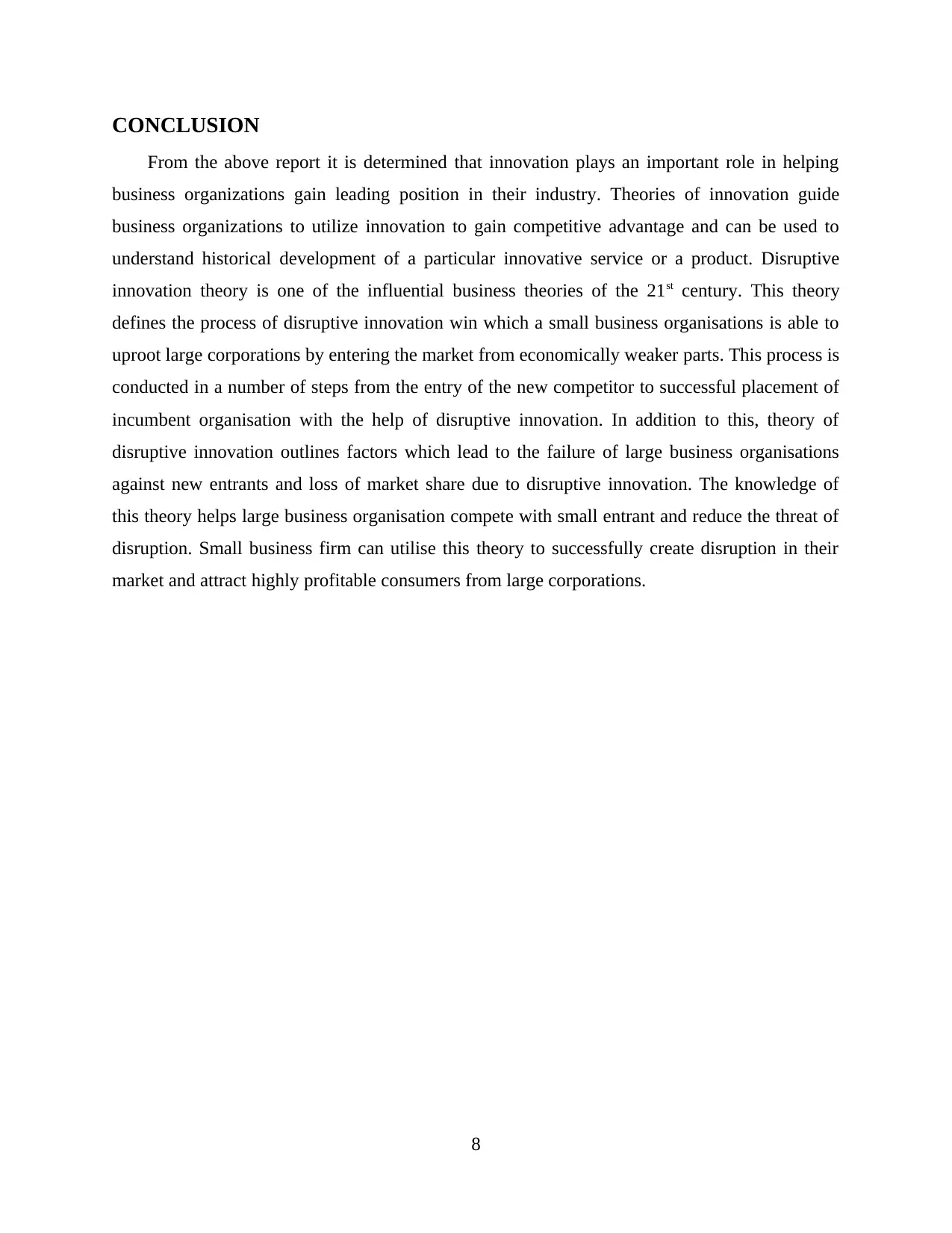
CONCLUSION
From the above report it is determined that innovation plays an important role in helping
business organizations gain leading position in their industry. Theories of innovation guide
business organizations to utilize innovation to gain competitive advantage and can be used to
understand historical development of a particular innovative service or a product. Disruptive
innovation theory is one of the influential business theories of the 21st century. This theory
defines the process of disruptive innovation win which a small business organisations is able to
uproot large corporations by entering the market from economically weaker parts. This process is
conducted in a number of steps from the entry of the new competitor to successful placement of
incumbent organisation with the help of disruptive innovation. In addition to this, theory of
disruptive innovation outlines factors which lead to the failure of large business organisations
against new entrants and loss of market share due to disruptive innovation. The knowledge of
this theory helps large business organisation compete with small entrant and reduce the threat of
disruption. Small business firm can utilise this theory to successfully create disruption in their
market and attract highly profitable consumers from large corporations.
8
From the above report it is determined that innovation plays an important role in helping
business organizations gain leading position in their industry. Theories of innovation guide
business organizations to utilize innovation to gain competitive advantage and can be used to
understand historical development of a particular innovative service or a product. Disruptive
innovation theory is one of the influential business theories of the 21st century. This theory
defines the process of disruptive innovation win which a small business organisations is able to
uproot large corporations by entering the market from economically weaker parts. This process is
conducted in a number of steps from the entry of the new competitor to successful placement of
incumbent organisation with the help of disruptive innovation. In addition to this, theory of
disruptive innovation outlines factors which lead to the failure of large business organisations
against new entrants and loss of market share due to disruptive innovation. The knowledge of
this theory helps large business organisation compete with small entrant and reduce the threat of
disruption. Small business firm can utilise this theory to successfully create disruption in their
market and attract highly profitable consumers from large corporations.
8
Paraphrase This Document
Need a fresh take? Get an instant paraphrase of this document with our AI Paraphraser
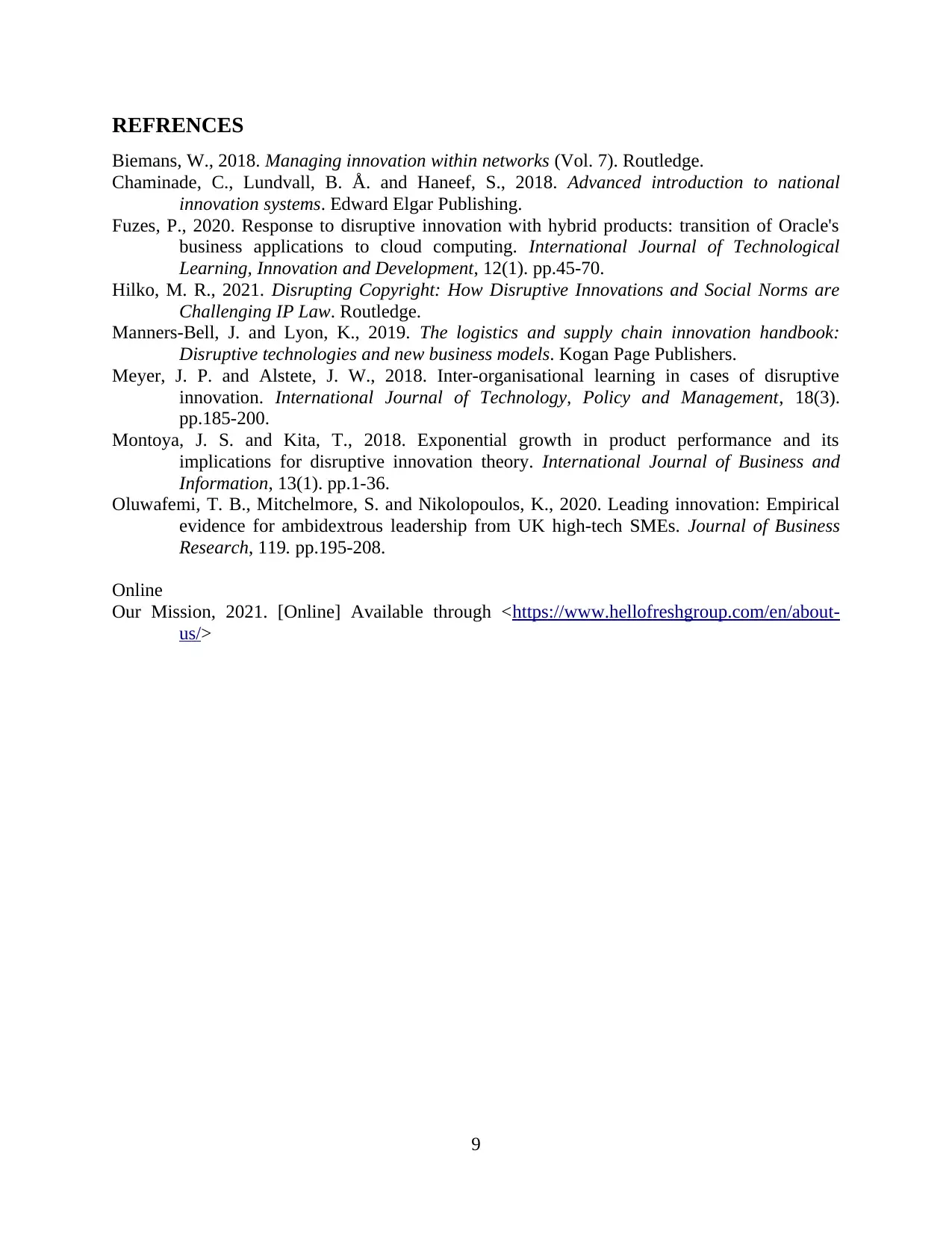
REFRENCES
Biemans, W., 2018. Managing innovation within networks (Vol. 7). Routledge.
Chaminade, C., Lundvall, B. Å. and Haneef, S., 2018. Advanced introduction to national
innovation systems. Edward Elgar Publishing.
Fuzes, P., 2020. Response to disruptive innovation with hybrid products: transition of Oracle's
business applications to cloud computing. International Journal of Technological
Learning, Innovation and Development, 12(1). pp.45-70.
Hilko, M. R., 2021. Disrupting Copyright: How Disruptive Innovations and Social Norms are
Challenging IP Law. Routledge.
Manners-Bell, J. and Lyon, K., 2019. The logistics and supply chain innovation handbook:
Disruptive technologies and new business models. Kogan Page Publishers.
Meyer, J. P. and Alstete, J. W., 2018. Inter-organisational learning in cases of disruptive
innovation. International Journal of Technology, Policy and Management, 18(3).
pp.185-200.
Montoya, J. S. and Kita, T., 2018. Exponential growth in product performance and its
implications for disruptive innovation theory. International Journal of Business and
Information, 13(1). pp.1-36.
Oluwafemi, T. B., Mitchelmore, S. and Nikolopoulos, K., 2020. Leading innovation: Empirical
evidence for ambidextrous leadership from UK high-tech SMEs. Journal of Business
Research, 119. pp.195-208.
Online
Our Mission, 2021. [Online] Available through <https://www.hellofreshgroup.com/en/about-
us/>
9
Biemans, W., 2018. Managing innovation within networks (Vol. 7). Routledge.
Chaminade, C., Lundvall, B. Å. and Haneef, S., 2018. Advanced introduction to national
innovation systems. Edward Elgar Publishing.
Fuzes, P., 2020. Response to disruptive innovation with hybrid products: transition of Oracle's
business applications to cloud computing. International Journal of Technological
Learning, Innovation and Development, 12(1). pp.45-70.
Hilko, M. R., 2021. Disrupting Copyright: How Disruptive Innovations and Social Norms are
Challenging IP Law. Routledge.
Manners-Bell, J. and Lyon, K., 2019. The logistics and supply chain innovation handbook:
Disruptive technologies and new business models. Kogan Page Publishers.
Meyer, J. P. and Alstete, J. W., 2018. Inter-organisational learning in cases of disruptive
innovation. International Journal of Technology, Policy and Management, 18(3).
pp.185-200.
Montoya, J. S. and Kita, T., 2018. Exponential growth in product performance and its
implications for disruptive innovation theory. International Journal of Business and
Information, 13(1). pp.1-36.
Oluwafemi, T. B., Mitchelmore, S. and Nikolopoulos, K., 2020. Leading innovation: Empirical
evidence for ambidextrous leadership from UK high-tech SMEs. Journal of Business
Research, 119. pp.195-208.
Online
Our Mission, 2021. [Online] Available through <https://www.hellofreshgroup.com/en/about-
us/>
9
1 out of 11
Related Documents
Your All-in-One AI-Powered Toolkit for Academic Success.
+13062052269
info@desklib.com
Available 24*7 on WhatsApp / Email
![[object Object]](/_next/static/media/star-bottom.7253800d.svg)
Unlock your academic potential
Copyright © 2020–2025 A2Z Services. All Rights Reserved. Developed and managed by ZUCOL.




